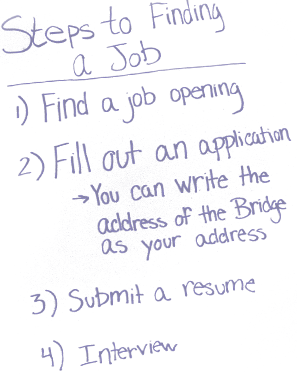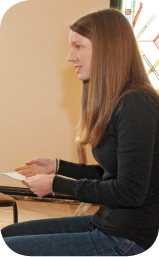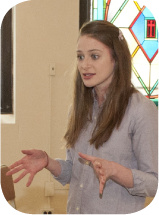OT student Sarah Lauterbach, Adam Pearson, OTD, OTR/L, OT student Brittany Perez, the Rev. Kathleen Wilder, executive director, and Christine Berg, PhD, OTR/L, at Centenary United Methodist Church, home of The Bridge
PHOTO BY RAY MARKLIN
BY STEPHANIE STEMMLER
At a homeless day shelter in St. Louis, 27-year-old Rashad McGlone struggles to find his way back to a productive life.
“I’m not a bad person,” he says softly. “Drugs overwhelmed me. Now I need to figure out how to get a job. Here, I can get away from those negative things that were all around and identify what I need to do.”
McGlone is one of a handful of men who are listening to Allison J. L’Hotta, a doctoral student in the Program in Occupational Therapy at Washington University School of Medicine. As part of her coursework, L’Hotta is not only learning how to give community talks, she also has identified resources in the surrounding neighborhood that can help participants with resume development, job searches, even suitable clothes for a job interview.
“She got my attention with her eyes,” says McGlone. “I matter, and she’s showing me she has something important to say of interest to me.”
On average, up to 500 people visit The Bridge shelter daily, seeking meals and a warm place to rest and socialize. “We’re ground zero for people who are displaced for whatever reason,” says Rev. Kathleen Wilder, executive director. “We function as a triage center, but we also offer resources that help get people back on their feet whenever they are ready to transition to jobs and independent living.”
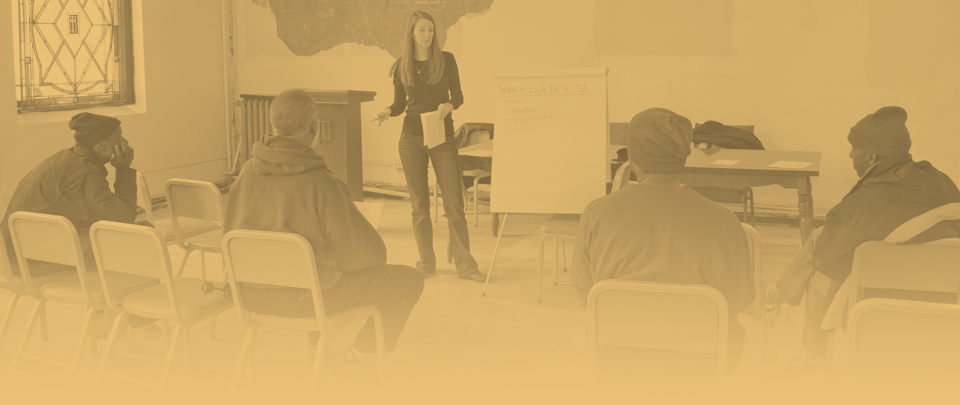
With limited resources and staff, The Bridge benefits from an outreach partnership with Washington University’s occupational therapy program, which provides students and faculty to interview guests at The Bridge, identify needs, and develop solutions that can be implemented by Bridge staff. Those solutions often include basic skills training, goal planning, and adaptive as well as motivational strategies.
“It’s a huge gift,” says Wilder. “Their ability to do basic skills assessments enables us to better understand what our guests need to transition away from being homeless. A social worker can do crisis intervention, but we’ve seen the value of an occupational therapist who is focused on identifying the skills each person has and the barriers they need to overcome to reach their goals.”

Not many people would expect to see an occupational therapist in a community setting, but the Program in Occupational Therapy is pushing the field back to its historic roots.
“A century ago, occupational therapists were part of the fabric of the community, helping the homeless, the war wounded, the mentally ill,” says M. Carolyn Baum, PhD, OTR/L, FAOTA, the Elias Michael Director of the Program in Occupational Therapy. “Then our role predominantly moved into hospitals and rehabilitation facilities as payment models moved toward institutionalized care. For the past decade, we’ve been pushing to re-introduce our involvement in the community because we have the expertise to teach life skills, and we need to provide those services where people reside or seek help.”
Over the last five years, students pursuing masters and doctoral degrees in occupational therapy have been required to do fieldwork in community practice settings. The variety of settings offers a wide diversity of locations and populations, at times giving students eye-opening experiences.
“Although I’ve served in soup kitchens many times before, I’ve never actually sat down and conversed over a meal with another individual,” says Christina T. Davison, a doctoral student who was at The Bridge assessing needs. “It really broke down a wall, seeing past the stereotypes.
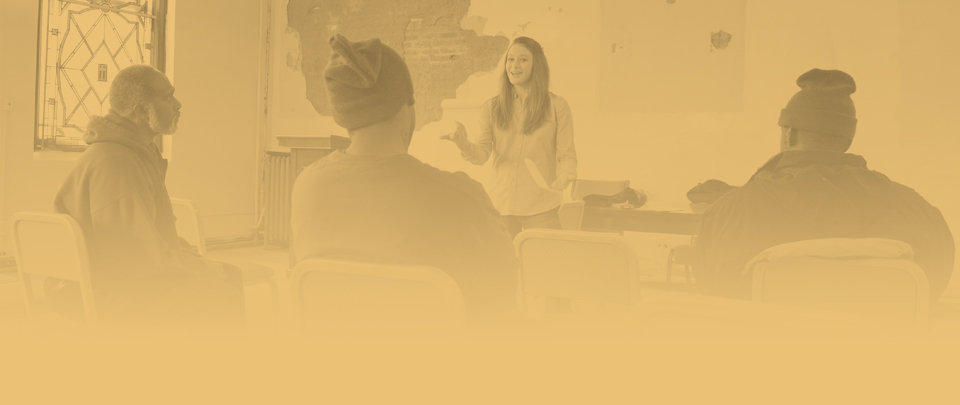
“Our skills can help with teaching others how to transition from one stage to the next,” Davison adds. “Examples here may be creating ways to teach life skills, such as budgeting and home management, to help these individuals move toward sustainable housing. We hope to provide The Bridge a program that will help place stepping stones to move individuals forward in their lives towards independence.”
Short “micro-teach” programs created for The Bridge focus on health maintenance and employment exploration. Jamie L. McGaha, a doctoral student, recently discussed infection prevention. “So what are the signs that your cut is not healing well?” she asks a group of homeless men. “How about if you touch it and it feels hot? Or if you see something is leaking out of the cut? Have you ever seen that?”
Her audience nods. A short but lively discussion concludes with McGaha offering information about the locations of nearby free health clinics.
“Occupational therapists are adept at breaking down a task step by step, sharing that information with an individual or organization, and then focusing on motivation, readiness to change, and necessary life skills and adaptive changes,” says instructor Jeanenne M. Dallas, MA, OTR/L. “In a hospital setting, that may be helping a patient recover after a stroke, but in a community setting it may be teaching people how to adapt to chronic illnesses or injuries, or overcome societal issues such as homelessness.”
Doctoral student Gregory S. Seymour agrees. “Personally, I am ecstatic that occupational therapy has moved back into a community role. I have seen firsthand the difference that we can make helping individuals return to important occupations such as cooking, attending school, working and spending time with their families.”
Steven D. Taff, PhD, OTR/L, associate director of professional programs for the Program in Occupational Therapy, reviews the teaching skills of doctoral students Allison J. L’Hotta, center, and Jamie L. McGaha.

At The Bridge, in particular, a close partnership has blossomed. Assistant professor Catina Callahan O’Leary, PhD, LMSW, lives three blocks from The Bridge and now serves as president of the organization’s board of directors. “We’ve shown that occupational therapy can play a critical role here. We developed an educational model to teach our students, but in reality, we’ve also built a strong link to the community where we should be, and want to be, actively engaged.”
Sixty-year-old Mark Jackson holds a building maintenance job but has been coming to The Bridge and other shelters for more than nine years. “My mind is open,” he says. “I’m trying to figure out how to get — and keep — my own place. I haven’t figured it out yet and I’m hoping people like them,” he says as he gestures to students L’Hotta and McGaha, “can help me. I don’t want a handout. I want a hand up.”
“Anywhere you interface with human beings, you have the potential for occupational therapy,” says Wilder, noting that The Bridge has decided to hire a part-time occupational therapist from the Washington University Program in Occupational Therapy later this year. “Because of this program, I see, and believe in, the power of occupational therapy to effect positive change.”
occupational therapy reaches out
The Bridge homeless day shelter is one of 30 St. Louis community organizations that has benefited from the Program in Occupational Therapy’s commitment to “service learning,” which integrates meaningful community service with instruction and reflection.
“Our students perform a service while they learn,” says Christine R. Berg, PhD, OTR/L, assistant professor of occupational therapy and of neurology, who leads the effort to identify organizations that need and could benefit from occupational therapy assistance.
“We ask agencies to identify a challenge, and we give them a group of students and a faculty mentor who can meet with participants and then propose potential solutions that the agency can implement.”
Parent/Teacher Education
Almost Home
Grace Hill Settlement Center*
Queen of Peace Center and Peace for Kids Development Center
Southside Day Nursery Learning Center
The Bridge*
The Kingdom House*
Youth in Need Project Head Start East
Youth Skill Development
Central Institute for the Deaf
EnTeam-Learning to Win Together
Loosen the Leash: Train a dog, Save a kid*
North Grand Neighborhood Services, Angel Baked Cookies*
Paraquad Independent Living Center
Small Rain
The National Children’s Cancer Society, Beyond the Cure*
Building Health Resources
American Parkinson Disease Association
Barnes-Jewish Behavioral Health
Casa de Salud (“House of Health”)*
Enabling Mobility Center
Gateway Area Chapter of National Multiple Sclerosis Society
Shearwater High School*
St. Louis Area Agency on Aging and Disability Resource Center
The Learning Tree Intergenerational Day Care Center
Community Services
Community Health in Partnership Services
Edgewood Children’s Center
Enabling Mobility Center
Mary Ryder Home
Peter & Paul Community Services
The Mary Culver Home for the Visually Impaired
The St. Louis NORC (of the Jewish Federation; Naturally Occurring Retirement Community)*
Employee, Volunteer and Alumni Programs
Center for Women in Transition
Girl Scouts of Eastern Missouri
HealthStreet
Mental Health Association of Eastern Missouri
The Mission Continues*
The Rehabilitation Institute of St. Louis
Voices for Children
Youth Exploring Science, a program of the St. Louis Science Center*
* agency partners in 2012






